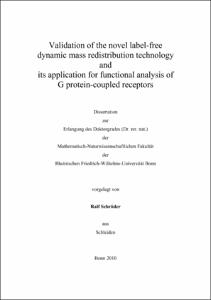Schröder, Ralf: Validation of the novel label-free dynamic mass redistribution technology and its application for functional analysis of G protein-coupled receptors. - Bonn, 2011. - Dissertation, Rheinische Friedrich-Wilhelms-Universität Bonn.
Online-Ausgabe in bonndoc: https://nbn-resolving.org/urn:nbn:de:hbz:5N-25752
Online-Ausgabe in bonndoc: https://nbn-resolving.org/urn:nbn:de:hbz:5N-25752
@phdthesis{handle:20.500.11811/5000,
urn: https://nbn-resolving.org/urn:nbn:de:hbz:5N-25752,
author = {{Ralf Schröder}},
title = {Validation of the novel label-free dynamic mass redistribution technology and its application for functional analysis of G protein-coupled receptors},
school = {Rheinische Friedrich-Wilhelms-Universität Bonn},
year = 2011,
month = jul,
note = {The dynamic mass redistribution (DMR) technology is a label-free assay platform that allows non-invasive and real-time recording of integrated cellular responses in living cells upon activation of G protein-coupled receptors (GPCRs), which represent one of the most important drug target classes. The cumulative response of the whole cell is captured by detection of refractive index alterations with an optical biosensor, resulting in distinct "signatures" which in turn reflect receptor activity.
The applicability of DMR technology for GPCR basic research was investigated by using the chemo attractant receptor homologous molecule expressed on T helper type2 (Th2) cells (CRTH2), the E-prostanoid receptors (EP) EP2/EP4, the free fatty acid receptor 1 (FFA1) and GPR55 as representatives for Gαi/0, Gαs, Gαq/11/(Gαi/0) and Gα12/13-linked signaling events, respectively. The cellular mechanisms underlying the individual responses were precisely assigned using a panel of toxins and pathway modulators and enabled to define heterotrimeric G proteins as post-receptor trigger for the complex DMR responses. Detection of receptor activation in parallel second messenger assays was in good agreement with DMR-derived results. Not accessible by conventional second messenger assays, detection of Gα12/13-mediated signaling by DMR technology was demonstrated utilizing a dominant negative form of the Gα13 protein (Gα13dn, Q226L,D294N). This reveals that the holistic nature of DMR reflects GPCR functionality along all four major G protein signaling pathways and defines heterotrimeric G proteins as post-receptor trigger for the complex DMR responses.
Application of the DMR technology in a ligand screen at the pro-inflammatory prostaglandin D2 (PGD2) receptor CRTH2 revealed new endogenous agonists such as prostaglandin H2 (PGH2), the precursor of the 2-series prostanoids. This might propose receptor activation in spite of potential, therapeutic blockage of prostaglandin synthase (PGDS).
It is suggested that DMR represents an enabling technology for both GPCR basic research and drug discovery.},
url = {https://hdl.handle.net/20.500.11811/5000}
}
urn: https://nbn-resolving.org/urn:nbn:de:hbz:5N-25752,
author = {{Ralf Schröder}},
title = {Validation of the novel label-free dynamic mass redistribution technology and its application for functional analysis of G protein-coupled receptors},
school = {Rheinische Friedrich-Wilhelms-Universität Bonn},
year = 2011,
month = jul,
note = {The dynamic mass redistribution (DMR) technology is a label-free assay platform that allows non-invasive and real-time recording of integrated cellular responses in living cells upon activation of G protein-coupled receptors (GPCRs), which represent one of the most important drug target classes. The cumulative response of the whole cell is captured by detection of refractive index alterations with an optical biosensor, resulting in distinct "signatures" which in turn reflect receptor activity.
The applicability of DMR technology for GPCR basic research was investigated by using the chemo attractant receptor homologous molecule expressed on T helper type2 (Th2) cells (CRTH2), the E-prostanoid receptors (EP) EP2/EP4, the free fatty acid receptor 1 (FFA1) and GPR55 as representatives for Gαi/0, Gαs, Gαq/11/(Gαi/0) and Gα12/13-linked signaling events, respectively. The cellular mechanisms underlying the individual responses were precisely assigned using a panel of toxins and pathway modulators and enabled to define heterotrimeric G proteins as post-receptor trigger for the complex DMR responses. Detection of receptor activation in parallel second messenger assays was in good agreement with DMR-derived results. Not accessible by conventional second messenger assays, detection of Gα12/13-mediated signaling by DMR technology was demonstrated utilizing a dominant negative form of the Gα13 protein (Gα13dn, Q226L,D294N). This reveals that the holistic nature of DMR reflects GPCR functionality along all four major G protein signaling pathways and defines heterotrimeric G proteins as post-receptor trigger for the complex DMR responses.
Application of the DMR technology in a ligand screen at the pro-inflammatory prostaglandin D2 (PGD2) receptor CRTH2 revealed new endogenous agonists such as prostaglandin H2 (PGH2), the precursor of the 2-series prostanoids. This might propose receptor activation in spite of potential, therapeutic blockage of prostaglandin synthase (PGDS).
It is suggested that DMR represents an enabling technology for both GPCR basic research and drug discovery.},
url = {https://hdl.handle.net/20.500.11811/5000}
}






